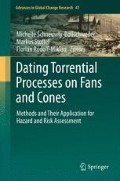Abstract
In this chapter, we present a successful application of optically-stimulated luminescence (OSL) dating for reconstructing Quaternary alluvial and colluvial terrace sequences in the Pisco valley of western Peru. Here, climate-driven changes in debris-flow activity resulted in sediment aggradation and subsequent dissection forming distinct terrace levels. The terraces are made up of rather well-sorted, polymict, clast-supported conglomerates at the base and monomict, matrix-supported breccias towards the top. Both the abundance and thicknesses of breccias increase upsection and form the top of each sequence, leading to fan-shaped geometries. The well-sorted and clast-supported fabric of the conglomerates is interpreted as deposition by the perennial braided Pisco trunk stream. In contrast, the matrix-supported breccias were deposited by debris-flows sourced locally in the adjacent tributary valleys. The superposition of breccias on conglomerates implies that tributary debris-flow fans prograded from the valley margin towards the centre. OSL dating reveals that initiation of sediment accumulation was concurrent with a shift to more humid conditions. OSL ages also show that sediment aggradation started at the valley outlet, with the locus of sediment deposition then propagating farther upstream. Subsequent erosion and dissection of the valley fill commenced later during the same humid interval and continued throughout the following drier climate. Interestingly, the destructive phases also started at the valley outlet and propagated upstream, presumably as the hillslope sediment reservoirs became depleted. It is concluded that the sedimentary fill of the Pisco valley, and presumably that in other mountain belts, records a transient, non-steady response of debris-flows and fluvial processes to climate change, where non-steady sediment flux by hillslope erosion is buffered for a limited time span.
Access this chapter
Tax calculation will be finalised at checkout
Purchases are for personal use only
References
Baker PA, Seltzer GO, Fritz SC, Dunbar RB, Grove MJ, Cross SL, Tapia P, Rowe HD, Broda JP (2001a) The history of South American tropical precipitation for the past 25,000 years. Science 291:640–643
Baker PA, Rigsby CA, Seltzer GO, Fritz SC, Lowenstein T, Bacher N, Veliz C (2001b) Tropical climate changes at millennial and orbital timescales on the Bolivian Altiplano. Nature 409:698–701
Blair TC (1999) Sedimentology of the debris-flow-dominated Warm Spring Canyon alluvial fan, Death Valley, California. Sedimentology 46:941–965
Blum MD, Törnqvist TE (2000) Fluvial responses to climate and sea-level change: a review and look forward. Sedimentology 47:2–48
Fannin RJ, Rollerson TP (1993) Debris flows: some physical characteristics and behaviours. Can Geotech J 30:71–81
Fritz SC, Baker PA, Lowenstein TK, Seltzer GO, Rigsby CA, Dwyer GS, Tapia PM, Arnold KK, Ku TL, Luo S (2004) Hydrologic variation during the last 170,000 years in the southern hemisphere tropics of South America. Quat Res 61:95–104
Gallino GL, Pierson TC (1984) Polallie Creek debris flow and subsequent dma-break flood of 1980, East Fork Hood River Basin, Oregon. Open file-report US Geological Survey 84–578. US Department of Interior, Geological Survery, Portland, 37 pp
Garreaud R, Vuille M, Clement AC (2003) The climate of the Altiplano: observed current conditions and mechanisms of past changes. Palaeogeogr Palaeoclimatol Palaeoecol 194:5–22
Iverson RS (1997) The physics of debris flows. Rev Geophys 35:245–296
Jakob M, Hungr O (2005) Introduction. In: Jakob M, Hungr O (eds) Debris-flow hazards and related phenomena. Springer, Berlin, pp 1–8
Jakob M, Bovis M, Oden M (2005) The significance of channel recharge rates for estimating debris-flow magnitude and frequency. Earth Surf Process Landf 30:755–766
Kober F, Ivy-Ochs S, Schlunegger F, Baur H, Kubik PW, Wieler R (2007) Denudation rates and topography-driven rainfall threshold in northern Chile: multiple cosmogenic nuclide data and sediment budgets. Geomorphology 83:97–120
McArdell B, Bartelt P, Kowalski J (2007) Field observations of basal forces and fluid pore pressure in a debris flow. Geophys Res Lett 34. doi:10.1029/2006GL029183
Mettier R, Schlunegger F, Schneider H, Schwab M, Rieke-Zapp D (2009) Relationships between landscape morphology, climate and surface erosion in northern Peru at 5°S latitude. Int J Earth Sci 98:2009–2022
Santi PM, deWolfe VG, Higgins JD, Cannon SH, Gartner JE (2008) Sources of debris flow material in burned areas. Geomorphology 96:310–321
Schildgen TF, Hodges KV, Whipple KW, Reiners PW, Pringle MS (2007) Uplift of the western margin of the Andean plateau revealed from canyon incision history, southern Peru. Geology 35:523–526
Schlunegger F, Zelinger G, Kounov A, Kober F, Hüsser B (2006) Scale of relief growth in the Andes of northern Chile. Terra Nova 18:217–223
Steffen D, Schlunegger F, Preusser F (2009) Drainage basin response to climate change in the Pisco valley, Peru. Geology 37:491–494
Steffen D, Schlunegger F, Preusser F (2010) Late Pleistocene fans and terraces in the Majes valley, southern Peru, and their relation to climatic variations. Int J Earth Sci 99(8):1975–1989
Tucker G, Slingerland R (1997) Drainage basin responses to climate change. Water Resour Res 33:2031–2047
Wieczorek GF (1987) Effect of rainfall intensity and duration on debris flows in central Santa Cruz Mountains, California. In: Costa JE, Wieczorek GF (eds) Debris flows/avalanches: process, recognition and mitigation, Geological Society of America, reviews in engineering geology 7. Geological Society of America, Boulder, pp 93–104
Author information
Authors and Affiliations
Corresponding author
Editor information
Editors and Affiliations
Rights and permissions
Copyright information
© 2013 Springer Science+Business Media Dordrecht
About this chapter
Cite this chapter
Schlunegger, F., Norton, K., Steffen, D. (2013). Timing the Interface Between Mass Wasting and Fluvial Processes with OSL. In: Schneuwly-Bollschweiler, M., Stoffel, M., Rudolf-Miklau, F. (eds) Dating Torrential Processes on Fans and Cones. Advances in Global Change Research, vol 47. Springer, Dordrecht. https://doi.org/10.1007/978-94-007-4336-6_19
Download citation
DOI: https://doi.org/10.1007/978-94-007-4336-6_19
Published:
Publisher Name: Springer, Dordrecht
Print ISBN: 978-94-007-4335-9
Online ISBN: 978-94-007-4336-6
eBook Packages: Earth and Environmental ScienceEarth and Environmental Science (R0)

